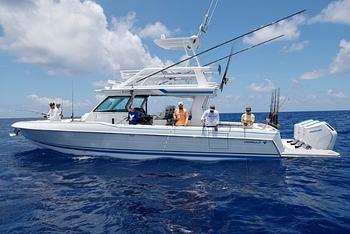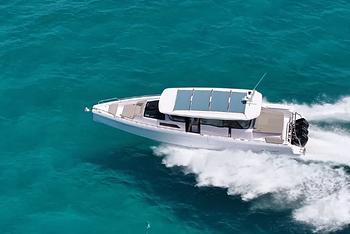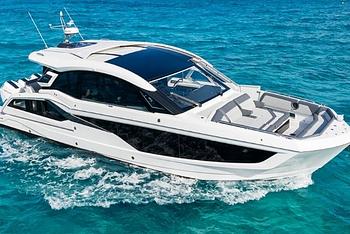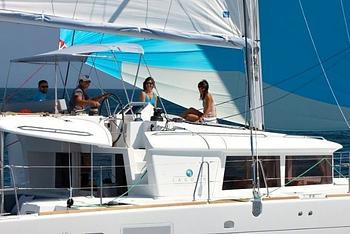The Hanse 388 fractional sloop was designed by Judel/Vrolijk & Co, a renowned German naval architecture firm known for their performance-oriented yet easy-to-sail cruising yachts. Introduced in 2017 as part of Hanse’s new midrange generation of sailboats, the model remained in production until 2024, demonstrating exceptional longevity. The 388 replaced the earlier Hanse 385 and it rides on the same hull, which was actually designed in 2012. The 388’s evolution added a modified deck mold, an upgraded Selden rig, and deeper cast iron keel, and it brought several refinements to onboard livability making her simultaneously new and familiar.
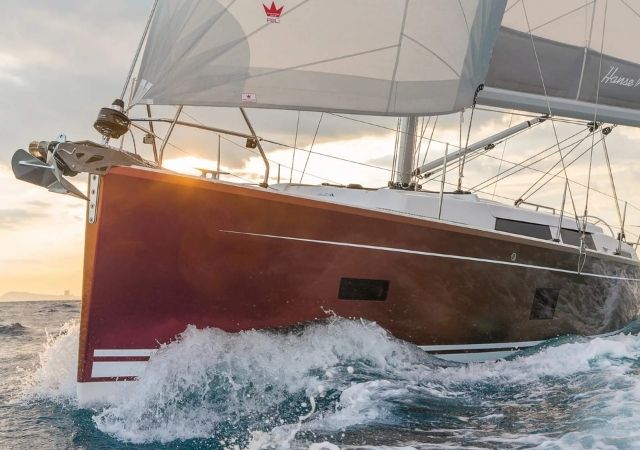
The Hanse 388 sleek lines and head turning design marries beauty with performance. Photo Credit for All: Hanse Yachts
Hanse 388 Key Features on Deck
The Hanse 388 is a balsa-cored sandwich construction with solid hand-laid glass around thru-hulls and even some carbon reinforcement at the chainplates. There’s an integrated structural grid for improved hull rigidity and load distribution. The opening transom and bow are plumb and a double roller stainless steel sprit provides an attachment point for a downwind sail. Large hullside windows were added and with her skylights and flush overhead hatches, the new design gained a more contemporary appeal. The hulls were laid up in Poland and finished out in Hanse’s facility in Greifswald, Germany.
At the bow, there’s an electric windlass and an opening anchor locker. A low molded-in toe rail that runs the perimeter of the deck provides just enough to brace yourself when the boat is heeling. Originally, there was an option for Flexiteek synthetic decking which holds up well and would be something to look for when shopping for a used boat. Lines are led aft from the mast under the deck and to the cockpit where Lewmar 40 primaries do yeoman's work. An electric upgrade was available and would be a worthy addition to any used boat to manage the continuous German mainsheet system as well as the jib sheets. There are arrays of rope clutches just ahead of these winches. The good news is they’re close to the helms so the driver can reach them. The bad news is they’re very close to the winches, making line handling tricky.
The Hanse 388 has twin wheels, which may seem a bit of overkill for a boat of this size but it helps in two ways. First, the placement of the wheels allows the driver to sit on the outboard coaming and enjoy good sightlines forward and up at the sails. Second, this configuration opens up the transit from the companionway to the transom and with the hinging helm seats out of the way, this creates an easy passage aft to jump in the water or board the dinghy.
Over the years, there were a few different styles offered of the folding cockpit table that sits between the settees. Perhaps the most practical one included a small integrated cubby at the center. On some versions, a 12-inch B&G multifunction display was mounted in a pod at the aft end of the table and on others, a fixed screen was integrated below table level. Neither option is great since the pod takes up a lot of space and the integrated version is hard to see. The starboard settee hides a cockpit locker that is either deep or half-depth if three cabins are optioned below. Overall, the cockpit is well-laid out even if not as massive as those on more recent models. A couple will be perfectly comfortable here whether entertaining or bashing to weather.
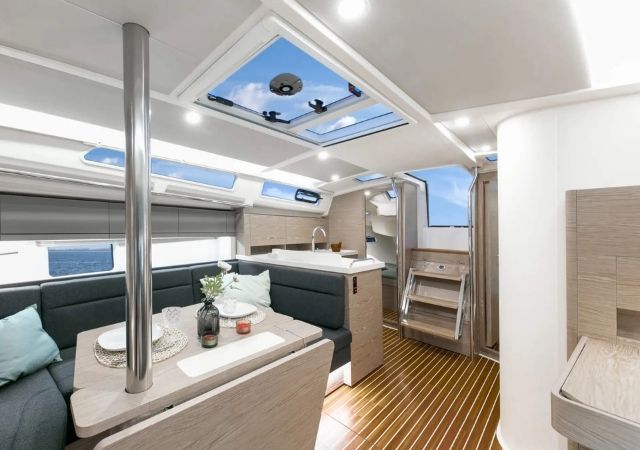
The skylights in the Hanse 388’s interior fill the saloon with abundant natural light.
Hanse 388 Key Features Below Deck
Below, the Hanse 388 clung to a more conservative approach, eschewing the open plan interiors that are prevalent today. The model offers 2-3 cabins and 1-2 heads. The base of the companionway is a busy place. To starboard is a compact L-shaped galley with a sink, microwave, two-burner cooktop/oven, and top/front-loading refrigeration. Good fiddles and nice handholds grace the inboard end of the countertop. Some versions extended the galley aft when a large stowage room took the place of the second aft cabin. There was also an option here for a separate shower stall in lieu of the longer galley.
To port is the entry to an aft cabin and a wet head with a manual toilet. Just ahead to port is an aft-facing navigation station with a breaker panel, a VHF radio, a Fusion stereo, and a small desk, which can be lowered to elongate the settee. Access to the fuse panel is below the desk and house batteries are tucked under the seat. Opposite is a drop-leaf table with built-in bottle storage and a C-shaped settee that has storage space below and behind as well as a lee cloth under the cushion that makes into an excellent sea berth.
The master cabin is in the V-berth. An overhead hatch brings in plenty of fresh air and the water tank and retractable bow thruster are below the bed. There are lockers on either side for decent storage. A second head can be squeezed into the starboard corner but that makes the stateroom tight and most couples in the US originally opted for the two-cabin, single head layout.
The saloon is bathed in light thanks to an overhead skylight, a large opening hatch and added hull windows. Below the saloon sole is a mini wine rack and good access to the keel bolts. USB plugs are located throughout and there was an initial choice of four wood veneers and cabin sole finishes and multiple fabrics so there will be some variations on the secondary market. Although the layout is classic, the design isn’t dated and a well-kept version still looks and feels contemporary today.
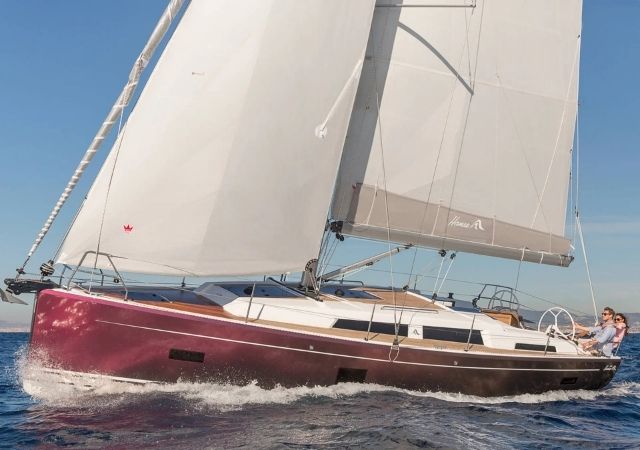
With tight upwind angles and lines run back to the helm sailing the Hanse 388 is designed to be a pleasure.
Hanse 388 Sailing Performance
While many builders embraced new approaches, on the 388, Hanse skipped the temptation of hard chines, inflated beams and twin rudders. A single deep spade rudder keeps the Hanse 388 tracking while her deeper keel keeps her upright. (A shoal keel was optional.) Her taller deck-stepped Selden rig with double aft-swept spreaders was fitted with either a classic hoist or a furling main. A self-tacking jib came standard but some owners added tracks for an overlapping genoa, especially if they were interested in club racing. A rigid vang was standard but there’s no traveler; instead the mainsheet connects directly to the coachroof ahead of the dodger so tweaking your sail trim is somewhat limited.
With the overlapping genoa, the Hanse 388 tacks through 80 degrees so she can sail tight on the wind and at this angle will generate around six knots of speed in 10-12 knots of true wind. If you crack off to a beam reach, expect speeds in the low 7-knot range. For couples seeking stress-free upwind performance and a versatile sail plan, the self-tacking jib and a Code 0 will get the job done. Hanse offered a “Performance Pack” with secondary winches on the cockpit coaming and laminated sails that pushed some boats toward the performance side of cruising.
The Hanse 388 came standard with a Yanmar SD25 29-hp diesel that some owners upgraded to a 39-hp model. Both were fitted with a saildrive that owners have had a love/hate relationship with due to maintenance. Service is required every 100 hours and the boat needs to be hauled out to drain the oil from the lower drain plug fitting. The seal also needs to be replaced every 5-7 years depending on hours of use.
The upgraded engine has the power to push through head seas and will generate a cruising speed of 6-7 knots, which is respectable on a boat in this class. Some owners replaced the standard two-blade propeller with a three-blade or even a folding prop so look for those upgrades on the secondary market because they will make a difference.
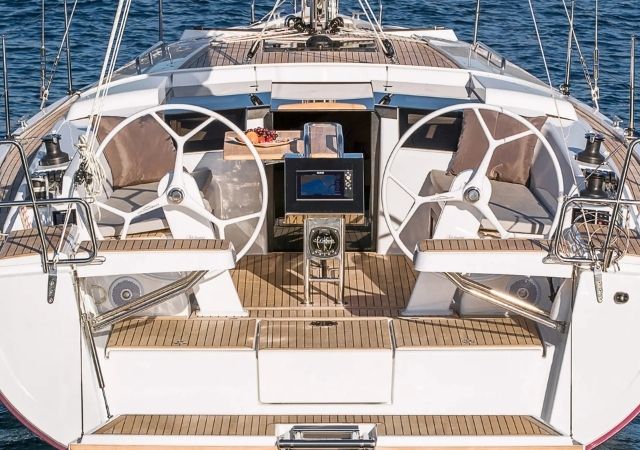
Twin wheels on the Hanse 388 with folding seats.
Hanse 388 Pros & Cons
Equipped with a self-tacking jib and optional in-mast furling, the Hanse 388 is easily sailed by two and can even be single-handed so going on the water for some after-work stress relief won’t be an ordeal. With her new rig and keel, she’s just fast enough to be exciting but also steady and stable to build confidence. Despite a fairly traditional layout, the interior feels modern thanks to contemporary finishes and lots of natural light.
Her challenges include limited tankage (77 gallons of water and 42, of fuel) which will require careful planning for extended passagemaking and remote cruising. Reminiscent of old school designs, the side decks become narrow and get tight around the cockpit, especially if a Bimini structure is installed. And finally, the placement of the plotter and the compass on/in the aft end of the cockpit table doesn’t make either easy to use.
Why Buy a Hanse 388 Used?
Because the Hanse 388 was produced for such a long time, base pricing changed over the years and moved from $230,000 to over $300,000. On the pre-owned market, the buyer reaps the rewards not only because they’ve essentially skipped the initial depreciation, but also because many of these boats were upgraded with aftermarket gear like electronics, solar panels and dodgers by previous owners and that is often not reflected in the current price. Insurance costs will be lower than for a new boat, and this model has a robust network of owners to tap for feedback and support with maintenance and troubleshooting. Finally, this was a popular design for a long time so availability on the used market is good.
Conclusion
The Hanse 388 is a simple and somewhat traditional design known for its performance, comfort, ease of use, and value. It’s neither a high-performance racer nor a bluewater explorer but its well-roundedness is its strength. With a proven hull and essential gear already installed and tested, a used Hanse 388 represents good value as an agile and versatile sailing machine.
Hanse 388 Technical Specifications:
Designer: Judel / Vrolijk & Co
LOA: 37' 5"
LWL: 34’ 1”
Beam: 12' 10"
Draft: 5’4" – 6’ 9”
Sail Area: 775 sq. ft.
Displacement (light): 18,232 lbs.( L-keel)
Water: 77 gal.
Fuel: 42 gal.
Air draft: 57’ 9”
Engine: 29-39 hp Yanmar diesel w/ Saildrive

